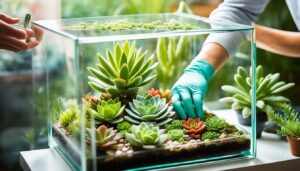Introduction
In the bustling world of indoor gardening, where greenery meets innovation, palm house plants stand as timeless emblems of elegance and tranquility. These majestic botanical wonders have captivated enthusiasts for centuries, adorning living spaces with their lush foliage and exotic allure. As we delve into the lush realm of palm house plants, we embark on a journey that transcends mere horticulture; it’s a voyage into the heart of nature’s resplendent beauty, where each frond whispers tales of tropical splendor.
Stay tuned as we uncover the secrets behind cultivating and caring for these verdant treasures, exploring their diverse varieties, and discovering the unparalleled joy they bring to indoor landscapes. Join us as we traverse the verdant corridors of palm house plants, where every leaf unfurls a new chapter in the art of botanical appreciation.
Embracing Variety: A Cornucopia of Palm House Plant Species
In the enchanting world of palm house plants, diversity reigns supreme. From the towering majesty of the Areca Palm to the delicate fronds of the Lady Palm, each species offers a unique charm and aesthetic appeal. Let’s embark on a botanical odyssey through some of the most beloved varieties:
- Areca Palm (Dypsis lutescens): Revered for its graceful arching fronds and slender stems, the Areca Palm exudes tropical splendor. With proper care, this palm can reach towering heights, making it a striking focal point in any indoor landscape.
- Kentia Palm (Howea forsteriana): Renowned for its elegant, dark green foliage and resilient nature, the Kentia Palm thrives in low-light conditions, making it an ideal choice for indoor environments. Its slow growth rate and air-purifying qualities further enhance its popularity among plant enthusiasts.
- Parlor Palm (Chamaedorea elegans): As one of the most adaptable palm species, the Parlor Palm adds a touch of lushness to any interior space. Its compact size, feathery fronds, and tolerance for low-light conditions make it perfect for offices, bedrooms, and other areas with limited sunlight.
- Sago Palm (Cycas revoluta): Despite its name, the Sago Palm is not a true palm but rather a cycad, possessing a distinct prehistoric charm. Characterized by its stout trunk and stiff, glossy fronds, this resilient plant adds a touch of exoticism to indoor gardens and requires minimal maintenance.
- Majesty Palm (Ravenea rivularis): With its graceful arching fronds and feathery appearance, the Majesty Palm evokes images of lush tropical paradises. While it requires a bit more attention than some other palm species, its unparalleled beauty makes it well worth the effort.
Cultivating Green Serenity: Essential Care Tips for Palm House Plants
While palm house plants exude an aura of effortless elegance, proper care is essential to ensure their longevity and vibrancy. By understanding their unique needs and providing attentive maintenance, you can create an indoor oasis of green serenity. Let’s explore some essential care tips to help your palm house plants thrive:
- Light Requirements:
- Different palm species have varying light preferences. While some thrive in bright, indirect sunlight, others prefer lower light conditions.
- Place palms like the Areca Palm and Kentia Palm in bright, indirect light, while species such as the Parlor Palm and Bamboo Palm can tolerate lower light levels.
- Avoid exposing palms to direct sunlight for extended periods, as this can scorch their delicate fronds.
- Watering Frequency:
- Proper watering is crucial for palm house plants. While they enjoy consistently moist soil, overwatering can lead to root rot, while underwatering can cause dehydration.
- Water palms thoroughly when the top inch of soil feels dry to the touch, ensuring that excess water drains away to prevent waterlogged roots.
- Adjust your watering frequency based on environmental factors such as temperature, humidity, and the plant’s growth stage.
- Humidity Levels:
- Most palm species originate from tropical regions with high humidity levels. Mimicking these conditions indoors can promote healthy growth and prevent issues like leaf browning.
- Increase humidity around palm house plants by using a humidifier, placing them on trays filled with pebbles and water, or regularly misting their foliage with water.
- Temperature and Environment:
- Palm house plants thrive in warm, stable environments with temperatures between 65°F and 85°F (18°C to 29°C).
- Protect palms from drafts, sudden temperature fluctuations, and exposure to cold air, which can cause stress and damage their foliage.
- Fertilization:
- Feed palm house plants with a balanced, water-soluble fertilizer formulated specifically for indoor palms.
- Apply fertilizer during the growing season (spring and summer) according to the manufacturer’s instructions, taking care not to overfertilize, which can lead to nutrient imbalances.
Enhancing Interior Aesthetics: Creative Uses of Palm House Plants in Home Decor
Palm house plants not only purify the air and promote a sense of well-being but also serve as versatile design elements that can elevate any interior space. Whether you’re aiming for a tropical paradise or a contemporary oasis, incorporating palms into your home decor adds a touch of natural elegance and sophistication. Let’s explore some creative ways to integrate palm house plants into your interior design scheme:
- Statement Focal Points:
- Use large palm specimens such as the Majesty Palm or Bamboo Palm as statement focal points in your living room, foyer, or dining area.
- Place them in decorative pots or planters and position them near windows or in empty corners to draw the eye and add visual interest to the space.
- Vertical Greenery:
- Create a striking vertical garden by arranging tall, slender palms like the Kentia Palm or Areca Palm in vertical planters or wall-mounted containers.
- Vertical greenery not only maximizes floor space but also adds depth and texture to walls, transforming them into living works of art.
- Tabletop Elegance:
- Showcase smaller palm varieties such as the Parlor Palm or Ponytail Palm on tabletops, shelves, or mantels to infuse rooms with a touch of botanical charm.
- Pair them with decorative containers or terrariums to create captivating vignettes that reflect your personal style and aesthetic preferences.
- Natural Room Dividers:
- Use tall palms like the Lady Palm or Sago Palm to create natural room dividers or partitions in open-concept spaces.
- Position them strategically to delineate different areas of the room while maintaining an open and airy ambiance.
- Botanical Accents:
- Incorporate palm house plants as botanical accents throughout your home decor, placing them on side tables, countertops, or bathroom vanities.
- Mix and match different palm species to create dynamic compositions that add a touch of greenery to every corner of your living space.
Nurturing Mind, Body, and Soul: The Therapeutic Benefits of Palm House Plants
Beyond their aesthetic appeal, palm house plants offer a plethora of therapeutic benefits that nurture not only the body but also the mind and soul. From purifying the air to reducing stress and promoting mindfulness, these verdant companions enrich our lives in profound ways. Let’s delve into the therapeutic benefits of cultivating palm house plants:
- Air Purification:
- Palm house plants play a crucial role in improving indoor air quality by absorbing harmful pollutants and releasing oxygen during photosynthesis.
- According to NASA’s Clean Air Study, certain palm species, such as the Areca Palm and Bamboo Palm, are highly effective at removing toxins like formaldehyde, benzene, and trichloroethylene from the air.
- Stress Reduction:
- Studies have shown that interacting with indoor plants, including palm house plants, can help reduce stress levels and promote relaxation.
- The act of caring for plants, such as watering, pruning, and repotting, provides a sense of purpose and accomplishment, fostering feelings of well-being and tranquility.
- Biophilic Connection:
- Humans have an innate affinity for nature, known as biophilia, which refers to the instinctive bond between people and living organisms.
- Bringing palm house plants into indoor environments satisfies our biophilic cravings, reconnecting us with the natural world and fostering a sense of harmony and balance.
- Enhanced Productivity:
- Research suggests that incorporating greenery into workspaces and study areas can enhance cognitive function, creativity, and productivity.
- By placing palm house plants in home offices, classrooms, or study nooks, individuals can create conducive environments that inspire focus and mental clarity.
- Mindfulness and Well-being:
- Cultivating palm house plants encourages mindfulness and promotes a sense of mindfulness, as it requires attentiveness and presence in the moment.
- Observing the growth and development of plants fosters a deeper appreciation for the cycles of nature, instilling a sense of wonder and gratitude for the beauty of life.
Sustainability in Indoor Gardening: Eco-Friendly Practices for Palm House Plant Enthusiasts
As the global focus on sustainability continues to grow, indoor gardening enthusiasts are seeking eco-friendly practices to minimize their environmental footprint while cultivating lush indoor landscapes. By adopting sustainable methods and making conscious choices, palm house plant enthusiasts can contribute to a greener future while enjoying the beauty of nature within their homes. Let’s explore some eco-friendly practices for palm house plant care:
- Choose Sustainable Potting Materials:
- Opt for pots and containers made from sustainable materials such as recycled plastic, bamboo, or terracotta.
- Avoid containers made from non-biodegradable materials like PVC or styrofoam, which contribute to landfill waste.
- Use Organic Fertilizers:
- Embrace organic fertilizers derived from natural sources such as compost, seaweed extract, or worm castings.
- Organic fertilizers promote soil health and microbial activity while reducing the risk of chemical runoff and pollution.
- Conserve Water:
- Practice water conservation by using efficient watering techniques such as drip irrigation or bottom watering.
- Collect rainwater for watering your palm house plants whenever possible, reducing reliance on treated tap water.
- Repurpose and Upcycle:
- Get creative with repurposing and upcycling containers and household items to use as planters and decorative accents.
- Transform old mason jars, tin cans, or wooden crates into charming homes for your palm house plants, adding a touch of character to your indoor garden.
- Support Local Nurseries:
- Source palm house plants from local nurseries and growers to minimize carbon emissions associated with transportation.
- By supporting local businesses, you can also promote biodiversity and contribute to the preservation of native plant species.
- Reduce Chemical Dependency:
- Limit the use of chemical pesticides and herbicides in your indoor garden, opting for natural pest control methods such as neem oil or insecticidal soap.
- Create a balanced ecosystem by introducing beneficial insects like ladybugs or predatory mites to control pest populations naturally.
Conclusion: Celebrating the Evergreen Splendor of Palm House Plants
In the verdant tapestry of indoor gardening, palm house plants stand as timeless icons of natural beauty and serenity. As we conclude our exploration of these botanical treasures, we are reminded of their enduring allure and profound impact on our lives. From their graceful fronds to their therapeutic benefits, palm house plants enrich our indoor environments in countless ways.
Throughout our journey, we’ve traversed the diverse landscapes of palm species, delved into essential care practices, and explored creative ways to incorporate them into home decor. We’ve also celebrated their therapeutic virtues, from purifying the air to fostering mindfulness and well-being.
As stewards of the Earth, we have a responsibility to cultivate our indoor gardens sustainably, embracing eco-friendly practices that honor the delicate balance of nature. By choosing sustainable materials, conserving water, and supporting local growers, we can nurture our palm house plants while minimizing our environmental footprint.
In the embrace of palm house plants, we find not only botanical beauty but also a profound connection to the natural world. Let us continue to cultivate these green companions with care and reverence, honoring their legacy of timeless elegance and everlasting splendor in our homes and hearts.
I hope you enjoyed our look into Palm Houseplants. This is a topic with a vast array of varieties. If you happen to be in our area you can see how we utilize our palms as well as all of our indoor garden varieties at The Landscape Connection. Happy Gardening!




